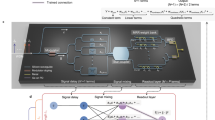Abstract
We propose photonic reservoir computing as a new approach to optical signal processing and it can be used to handle for example large scale pattern recognition. Reservoir computing is a new learning method from the field of machine learning. This has already led to impressive results in software but integrated photonics with its large bandwidth and fast nonlinear effects would be a high-performance hardware platform. Therefore we developed a simulation model which employs a network of coupled Semiconductor Optical Amplifiers (SOA) as a reservoir. We show that this kind of photonic reservoir performs even better than classical reservoirs on a benchmark classification task.
Preview
Unable to display preview. Download preview PDF.
Similar content being viewed by others
References
Jaeger, H., Haas, H.: Harnessing nonlinearity: Predicting chaotic systems and saving energy in wireless communication. Science 304, 78–80 (2004)
Maass, W., Natschläger, T., Markram, H.: Real-time computing without stable states: A new framework for neural computation based on perturbations. Neural Computing 14, 2531–2560 (2002)
Maass, W., Natschläger, T., Markram, H.: A model for real-time computation in generic neural microcircuits. In: Proceedings of NIPS, pp. 229–236. MIT Press, Vancouver (2003)
Skowronski, M.D., Harris, J.G.: Minimum mean squared error time series classification using an echo state network prediction model. In: Proceedings of IEEE International symposium on circuits and systems. Institute of Electrical and Electronics Engineers, Island of Kos (2006)
Verstraeten, D., Schrauwen, B., Stroobandt, D., Van Campenhout, J.: Isolated word recognition with the Liquid State Machine: a case study. Information Processing Lett. 95, 521–528 (2005)
Jaeger, H.: Reservoir riddles: Suggestions for echo state network research (extended abstract). In: Proceedings of IEEE International Joint Conference on Neural Networks, pp. 1460–1462. Institute of Electrical and Electronics Engineers, Montreal (2005)
Joshi, P., Maass, W.: Movement generation and control with generic neural micrrocircuits. In: Proceedings of BIO-ADIT, pp. 16–31. Springer, Berlin (2004)
Steil, J.J.: Online stability of backpropagation-decorrelation recurrent learning. Neurocomputing 69, 642–650 (2006)
Bishop, C.M.: Neural Networks for Pattern Recognition. Clarendon Press, Oxford (1995)
Vapnik, V.N.: An overview of statistical learning theory. IEEE Trans. Neural Networks 10, 988–999 (1999)
Legenstein, R., Maass, W.: What makes a dynamical system computationally powerful? In: New directions in statistical signal processing: from systems to brain, pp. 127–154. MIT Press, Cambridge (2007)
Reservoir lab: Reservoir Computing Toolbox, http://snn.elis.ugent.be/node/59
Verstraeten, D., Schrauwen, B., D’Haene, M., Stroobandt, D.: An experimental unification of reservoir computing methods. Neural Networks 20, 391–403 (2007)
Agrawal, G.P., Olsson, N.A.: Self-Phase Modulation and Spectral Broadening of Optical Pulses in Semiconductor-Laser Amplifiers. IEEE J. Quantum Electron. 25, 2297–2306 (1989)
Cernansky, M., Makula, M.: Feed-forward echo state networks. In: Proceedings of IEEE International Joint Conference on Neural Networks, pp. 1479–1482. Institute of Electrical and Electronics Engineers, Montreal (2005)
Author information
Authors and Affiliations
Editor information
Editors and Affiliations
Rights and permissions
Copyright information
© 2008 Springer-Verlag Berlin Heidelberg
About this paper
Cite this paper
Vandoorne, K. et al. (2008). Photonic Reservoir Computing with Coupled Semiconductor Optical Amplifiers. In: Dolev, S., Haist, T., Oltean, M. (eds) Optical SuperComputing. OSC 2008. Lecture Notes in Computer Science, vol 5172. Springer, Berlin, Heidelberg. https://doi.org/10.1007/978-3-540-85673-3_4
Download citation
DOI: https://doi.org/10.1007/978-3-540-85673-3_4
Publisher Name: Springer, Berlin, Heidelberg
Print ISBN: 978-3-540-85672-6
Online ISBN: 978-3-540-85673-3
eBook Packages: Computer ScienceComputer Science (R0)




